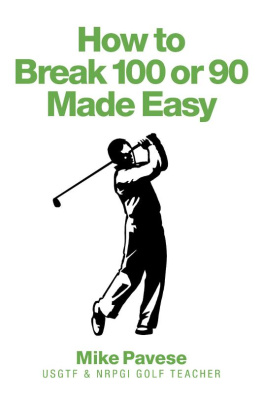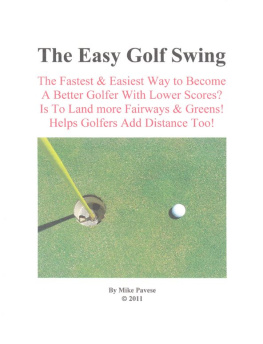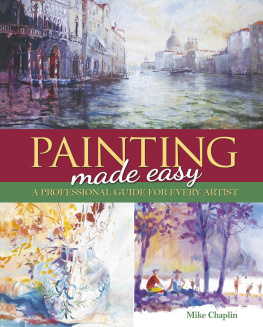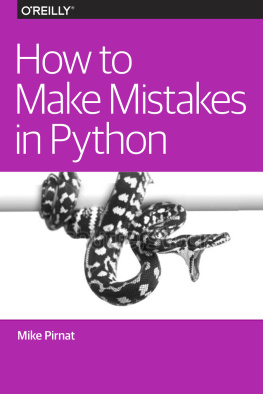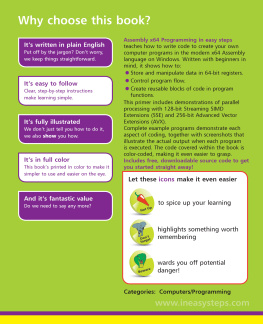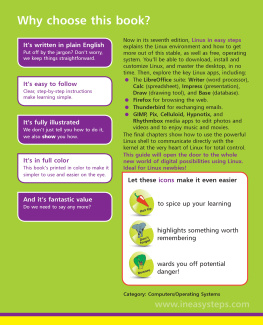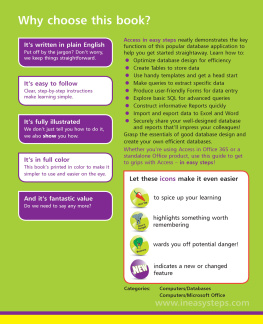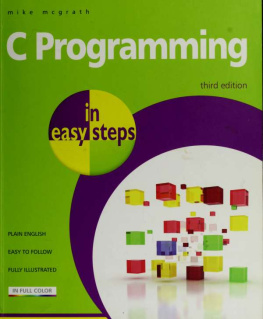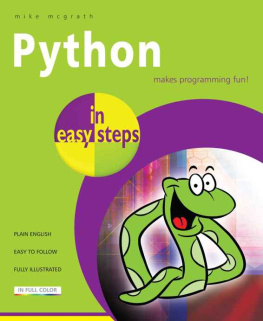Mike Pavese - How to Break 100 or 90 Made Easy
Here you can read online Mike Pavese - How to Break 100 or 90 Made Easy full text of the book (entire story) in english for free. Download pdf and epub, get meaning, cover and reviews about this ebook. year: 2013, publisher: BookBaby, genre: Children. Description of the work, (preface) as well as reviews are available. Best literature library LitArk.com created for fans of good reading and offers a wide selection of genres:
Romance novel
Science fiction
Adventure
Detective
Science
History
Home and family
Prose
Art
Politics
Computer
Non-fiction
Religion
Business
Children
Humor
Choose a favorite category and find really read worthwhile books. Enjoy immersion in the world of imagination, feel the emotions of the characters or learn something new for yourself, make an fascinating discovery.
- Book:How to Break 100 or 90 Made Easy
- Author:
- Publisher:BookBaby
- Genre:
- Year:2013
- Rating:5 / 5
- Favourites:Add to favourites
- Your mark:
- 100
- 1
- 2
- 3
- 4
- 5
How to Break 100 or 90 Made Easy: summary, description and annotation
We offer to read an annotation, description, summary or preface (depends on what the author of the book "How to Break 100 or 90 Made Easy" wrote himself). If you haven't found the necessary information about the book — write in the comments, we will try to find it.
How to Break 100 or 90 Made Easy — read online for free the complete book (whole text) full work
Below is the text of the book, divided by pages. System saving the place of the last page read, allows you to conveniently read the book "How to Break 100 or 90 Made Easy" online for free, without having to search again every time where you left off. Put a bookmark, and you can go to the page where you finished reading at any time.
Font size:
Interval:
Bookmark:
ISBN: 9781624885143
Table of contents
Introduction
I would like to state for the record that I am not a PGA Tour Pro or Instructor, nor am I a professional writer. There the Disclaimer out of the way.) I am however a USGTF & NRPGI certified golf teacher.
I have immense respect for all PGA pros & instructors. The real problem, most PGA instructors want to teach you "their" swing, or "the" swing, the Internet Gurus are only re-packaging those swings. All work with what I am about to tell and show you. No need to be concerned about having to lean a new swing or style of swing. I believe you were born with "Your Own Personal Golf Swing" that's all I am concerned about. I can state without any doubt you will never have anything but "Your Own Personal Golf Swing". No matter what style or type of swing you use your swing will only work for you! "No Other Golfer Will Ever Swing A Golf Club Same As You Do!"
Hello I'm Mike Pavese and I wrote this book to help impart golfing knowledge to a wider audience and give others a chance to learn how they can lower their own golf scores. Because your shots will become more accurate and consistent with less effort needed when you learn to play with only your 70% or better clubs. I'll show you how to find your 70% or better clubs. WHY? A golf club moving at 80, 110 or even 140 mph when it impacts the golf ball, the golf ball goes and does exactly what the golf clubs face just "told it to do". Open or close the clubs face at impact and say "Hello to TROUBLE!"
Chapter 1
Reality Check
Fact: Golf is so simple any one can break 100.
Yet the USGA stated" 50% of golfers worldwide can't break 100 every round." 50% of all golfers never break 100 forget 90, or 80. Why?
These are reasons for this the ones the Golf Industry never wanted you to know!
- You're not a pro golfer! You can't play like them.
Stop trying too.
- Your swing speed is most likely is less than 90-mph.
A Tour Pro swings between 110-140-mph.
- You want scores in the mid-80's or low 90's?
Lose the EGO!
- Use only your 70% or better clubs and swing them at 80% of your power level. Play golf with accuracy & consistency of that accuracy so the ball once on the green only takes 1 or 2 putts and not more.
- Practice time must be broken down into 3 groups. Shot Game, Putting, and the Long Game. How to break down the time you practice using the proper level and exercises in (Practice made fun). Practice for only 1- hour you won't get bored.
- Distance only sells stuff! New clubs, balls, Magazines, and Books
- Remember your 160-yard club is your best friend. There is no hole you can't par using it along with some consistent accuracy and good putting.
- Hitting with accuracy & consistency of that accuracy will lower your scores. Not those 300-yard Drives. Practicing the right things goes a long way also.
- Learn to think and play from the Cup back to the tee box.
- You can lean to sink 20, 6-foot putts in a row.
- You can get the ball to within 6ft of the cup on any green.
- You can hit your shots 70% or better every time you swing a club.
- You are going to see your scores going down, if you will use the things I show you.
- Golf is taught "Backasswards." You're taught to think from Tee box to Green. Learn to think cup to tee.
There is no one or only right way to hold and swing a golf club. You just have to stop buying the golf industry's hype. Once you have learned any style of swing that you can hit 160-yards accurately while staying in the fairway, or on the green, you have everything you need to shoot golf scores in the mid-80 to low 90s when playing from the 6000-6100-yards tees. For those that can only hit 125 yards, move up one tee. Play from the 5000- 5900-yard tee. Anyone hitting less than 125 yards should only play the shorter 9-hole style courses until they can play to within 10 over par on a par 27 or 30 course. (Score 37 to 40) Then start playing the longer 18-hole courses from the farthest tees forward.
The Golf industry is not your friend. They really don't care if you shoot 65 or 165, just as long as you buy the hot New Clubs, Balls, and other stuff this year. As for the PGA as long as you play golf they don't care either. According to the National Golf Foundation, an industry research and consulting service. The average golfer's score for 18-holes remains at about 100, and has for decades. That the average golf score is not declining remains a golf industry secret, and with good reason: In 2002, according to the National Golf Foundation, Americans spent $4.7 billion on golf equipment. Over 50% of it on $500 drivers and $200 putters, new technology designed to help golfers find a 4.25-inch cup in fewer shots. And it is working very well for the golf Industry.
My personal feeling is The PGA Style & type Swing is "not" the best for most golfers. It is a hard swing to learn to hit well. There are other styles and type of golf swing out there for those who have tried and failed or are looking for that first golf lesson.
The real facts of golf are, simply that, anyone can play good golf! Keep reading and you will learn how. There are Great golfers (Scores of 60 to 75). Better golfers (scores of 76 - 85). Good golfers (scores of (86-99). All the other golfers score 100 or more.
Hitting longer shots and not lowering your golf score? Let me state a fact about golf. "The Rules of Golf" book says you must have at least 1 club but "no more" than 14 total. You can shoot par 72 using fewer clubs once you know what clubs to use for
Most golfers and all high handicap golfers would shoot far lower scores faster if they only used a 3 wood or hybrid off the tee on every par 4 and par 5 holes. Golfers just add strokes using clubs they can't hit well.
You're the reason your scores & handicap (Get a USGA Handicap Index.) are not going lower. Not your clubs or balls. You are not a "BAD GOLFER"! You just "PLAY GOLF BADLY". Like picking the Wrong club for the distance need. You don't hit your fairway woods very well, yet you grab them for those 250-yard to the green shots. You need to learn play "Smarter Golf." You could have hit two 7-iron shots totaling 300 yards.
2 Putts per hole = 32 Putts per round.
What if you could hit the ball to within 12" of the hole on every green? The odds are you can't sink 18-12" putts in a row on the practice green, much less on the golf course.
Chapter 2
Smarter golf
Why playing a Smarter Golf Game = Lowers Scores. The answer is Golf shots the golfer can count on, ones where the golf ball just goes where the golfer wants it to go, be it in the fairway or onto a green near the cup. All this will be yours by following the ideas in this book about moving the ball forward by blending control with power while keeping the ball on a desired line of flights ending near or in the cup. Keep the above points in mind and you're on your way to consistent, accurate shot making. Golfers have to play smarter golf to really improve and shoot lower scores!
My proven Smarter Golf Theory is "The Distance you can hit the ball with the greatest accuracy is the real distance you need to hit a golf ball and is the key for you to playing better golf.
The well-known and used golf industries "EGO Golf Theory" is:
"The farther a golfer can hit the golf ball, the shorter their next shot to the green will be allowing the golfer to get closer to the pin and, there by lower scores will follow" this is a half-truth. Read on and learn the full truth! Consistently hitting the ball accurately is the real key to lower scores. I call it Smarter Golf, a
Next pageFont size:
Interval:
Bookmark:
Similar books «How to Break 100 or 90 Made Easy»
Look at similar books to How to Break 100 or 90 Made Easy. We have selected literature similar in name and meaning in the hope of providing readers with more options to find new, interesting, not yet read works.
Discussion, reviews of the book How to Break 100 or 90 Made Easy and just readers' own opinions. Leave your comments, write what you think about the work, its meaning or the main characters. Specify what exactly you liked and what you didn't like, and why you think so.

